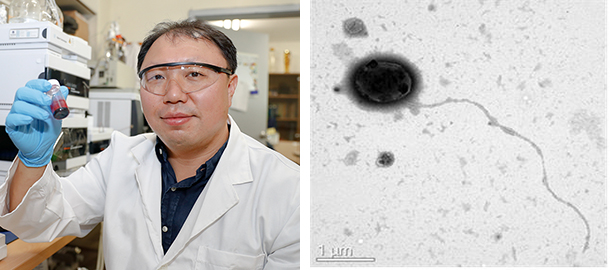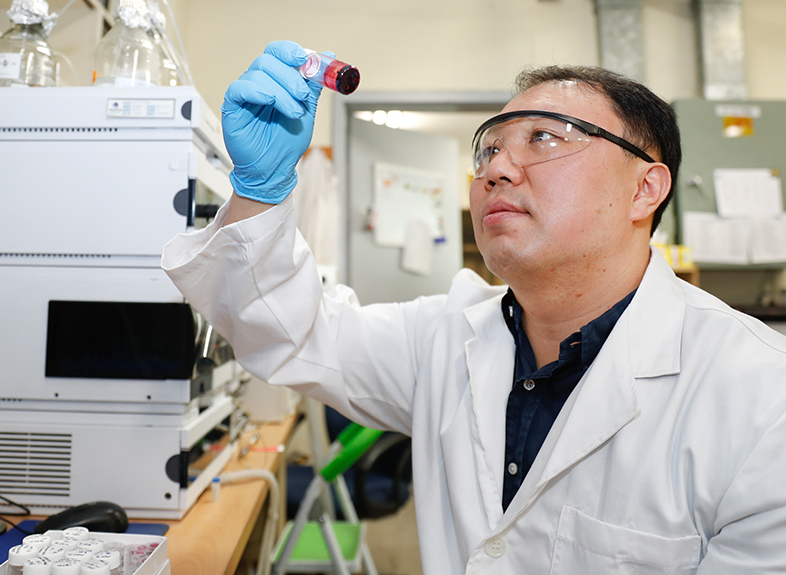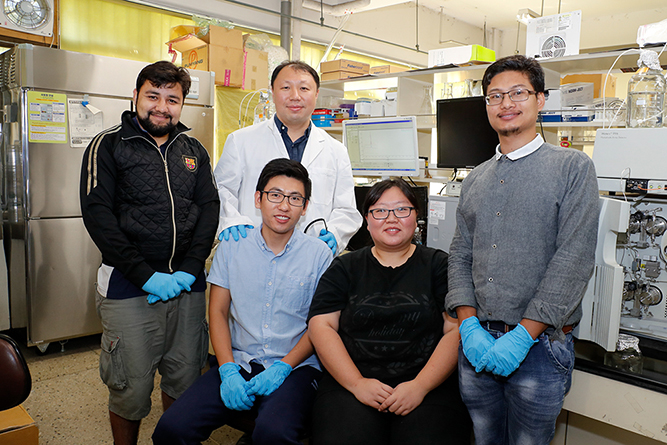Professor Choi Hyeok-jae Discovers ‘New Marine Microorganism’ that Produces Useful Antibiotics N
No.88997- Writer pr
- Date : 2017.09.20 13:14
- Views : 8157
College of Medicine Professor Choi Hyeok-jae’s research team joint research with the Marine Biodiversity Institute of Korea
Microorganism that produces useful antibiotics with excellent antibacterial and antibiosis functions
Finds optimal culturing conditions of microorganisms containing expensive antibacterial substances... Green light for the marine bio industry
[September 13, 2017]
Microorganism that produces useful antibiotics with excellent antibacterial and antibiosis functions
Finds optimal culturing conditions of microorganisms containing expensive antibacterial substances... Green light for the marine bio industry
[September 13, 2017]

<Professor Choi Hyeok-jae of the College of Medicine who discovered a new marine microorganism that produces useful antibacterial substances>
Upon culturing and analyzing marine microorganisms found in the sedimentary soil on the coastlines of Jeju, the Ministry of Oceans and Fisheries announced that it had confirmed that it contained prodigiosin, a substance with excellent antibacterial and antibiosis functions.
The research team of Professor Choi Hyeok-jae (left on photo) of the YU College of Medicine and the research team of Dr. Grace Choi of the Marine Biodiversity Institute of Korea discovered a new marine microorganism while exploring the sedimentary soil of the coastal regions in Gimnyeong, Jeju in March of last year. This substance was named Mabikibacter ruber after the name of the Marine Biodiversity Institute of Korea. The discovery of this microorganism was introduced globally by being published in the world’s most authoritative academic journal in the microorganism taxonomy sector, ‘IJSEM’ (International Journal of Systematic and Evolutionary Microbiology) on August 25, 2017.
Mabikibacter ruber is a word combining MABIK from the National Marine Biodiversity Institute of Korea and bacteria (bacter). ‘Ruber’, which means red in Latin, was added as it has a red color while being cultured.

Professor Choi said, “This strain was found by coincidence from marine sediment specimens that students on vacation collected.” He added, “This research was possible thanks to the students who are always interested in the surrounding nature.”
In order to check the biological structure and whether it contains useful materials, the research team cultured Mabikibacter ruber for seven months in a medium (liquid or solid compound with nutrients needed to culture microorganisms, plants, tissues and cells) and extracted the strings and conducted chemical analysis. They discovered that it contained prodigiosin, an antibiotic with a red color.
Prodigiosin is widely used as an antibacterial and antibiotic substance, while being effective against malaria. It is also being used for developing treatment for pancreatic cancer. There were also recent reports that prodigiosin suppresses the growth of borellia bacteria that causes lyme disease (infectious disease caused by a tick biting a person and spreading the borellia pathogenic bacteria in the human body causing diseases in various organs. The early symptoms are fevers, but when it advances, it can cause encephalitis, arrhythmia, myocarditis, etc.). It is thus expected that its value as an antibiotic will grow in the future.

<College of Medicine Professor Choi Hyeok-jae’s research team>
Professor Choi’s research team said, “In this study, we succeeded in the isolation and purification of prodigiosin, which was known to be very difficult, thus confirming the structure of prodigiosin that produces Mabikibacter ruber.” He added, “This substance is a prodigiosin derivative not available in the market, so its economic potential is enormous.”
The research team found the optimal culturing conditions that can produce prodigiosin in mass amounts through the process of culturing Mabikibacter ruber, and is planning to develop mass production technologies through this. Currently, prodigiosin-type antibiotics are being traded at high prices in the pharmaceutical markets, and in the event that mass production technologies are developed by the research team and the technologies are transferred to relevant industry, it is expected to contribute significantly to the activation of the marine bio industry.